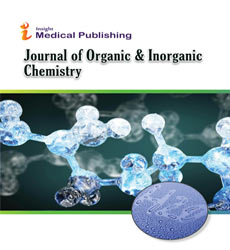Advances in MetalâÂÂorganic Frameworks (MOFs): From Structural Insights to Functional Applications
Alessandro Romano
Department of Chemical Sciences, University of Padua, Padua, Italy
Published Date: 2025-02-28DOI10.36648/2472-1123.11.1.124
Received date: February 03, 2025, Manuscript No. ipjoic-25-20812; Editor assigned date: February 05, 2025, PreQC No. ipjoic-25-20812 (PQ); Reviewed date: February 17, 2025, QC No. ipjoic-25-20812; Revised date: February 22, 2025, Manuscript No. ipjoic-25-20812 (R); Published date: February 28, 2025, DOI: 10.36648/2472-1123.11.1.124
Citation: Romano A (2025) Advances in Metal–organic Frameworks (MOFs): From Structural Insights to Functional Applications. J Org Inorg Chem Vol.11 No.1: 124.
Introduction
Metalâ??organic Frameworks (MOFs) have emerged as one of the most fascinating classes of crystalline porous materials, attracting significant attention across chemistry, materials science, and engineering. Comprising metal ions or clusters coordinated to organic linkers, MOFs offer tunable pore sizes, vast surface areas, and structural versatility. These unique attributes have positioned them as promising candidates for applications ranging from gas storage to catalysis and drug delivery. The rapid evolution of MOF research reflects both fundamental curiosity and practical demands for sustainable technologies. At the heart of MOF science lies the interplay between metal nodes and organic ligands. This modularity enables the construction of diverse topologies with controlled porosity. The ability to design frameworks using coordination chemistry principles allows for precise tailoring of pore geometry and chemical functionality. Unlike traditional porous solids such as zeolites or activated carbons, MOFs exhibit unparalleled structural diversity, offering opportunities to create highly customized materials for specific applications [1].
Description
The synthesis of MOFs has evolved significantly, with hydrothermal and solvothermal methods giving way to greener, more scalable approaches. Techniques such as microwave-assisted synthesis, mechanochemistry, and continuous-flow methods have improved reaction efficiency while minimizing solvent usage. Post-synthetic Modification (PSM) has further expanded the utility of MOFs, enabling functionalization without disrupting their crystalline framework. These innovations enhance structural stability and broaden application potential. A hallmark feature of MOFs is their extraordinary porosity and surface area, which often exceed 5,000 mò/g. This property allows them to host a variety of guest molecules, making them highly effective for adsorption and storage processes. The tunability of pore size and chemistry provides a level of control unmatched by conventional porous materials [2].
One of the most widely studied applications of MOFs is in gas storage and separation. MOFs have demonstrated exceptional capacity for hydrogen and methane storage, offering potential solutions to clean energy challenges. Similarly, their selective adsorption of carbon dioxide over nitrogen has positioned them as attractive candidates for Carbon Capture and Storage (CCS) technologies. Fine-tuning pore size and functional groups within MOFs enables highly selective separation of gases, crucial for energy and environmental sustainability [3].
MOFs have emerged as versatile catalysts due to their high surface areas, tunable active sites, and ability to incorporate metal clusters. They have been employed in diverse reactions such as oxidation, hydrogenation, and photocatalysis. Additionally, MOFs can function as enzyme mimics, providing biomimetic catalytic environments. Hybrid strategies that embed nanoparticles within MOFs further enhance catalytic performance, creating multifunctional systems with broad industrial relevance. Beyond energy and catalysis, MOFs have shown considerable promise in biomedicine. Their biocompatibility, tunable degradation rates, and high loading capacities make them suitable drug delivery platforms. MOFs can encapsulate therapeutic agents, protecting them from premature degradation and enabling controlled release. Furthermore, functionalized MOFs have been explored for imaging, biosensing, and theranostics, highlighting their versatility in clinical applications [4].
Environmental sustainability is another frontier where MOFs are making significant impact. Their ability to adsorb heavy metals, dyes, and organic pollutants from water has been extensively documented. The customizable surface chemistry of MOFs allows selective capture of hazardous species, offering a sustainable alternative to conventional adsorbents. In air purification, MOFs have been investigated for capturing Volatile Organic Compounds (VOCs) and toxic gases, further demonstrating their environmental utility [5].
Conclusion
Metalâ??organic frameworks exemplify the power of structural design in creating materials with remarkable functionality. From fundamental structural insights to diverse real-world applications, MOFs have reshaped expectations for porous materials. Despite challenges, continuous advances in synthesis, functionalization, and computational modeling are overcoming barriers, ensuring that MOFs remain at the forefront of materials science. Their integration into energy, environmental, and biomedical domains underscores their vast potential to address some of the most pressing challenges of the twenty-first century.
Acknowledgement
None.
Conflict of Interest
None.
References
- Wyllie AL, Fournier J, Casanovas-Massana A, Campbell M, Tokuyama M, et al. (2020). Saliva or nasopharyngeal swab specimens for detection of SARS-CoV-2. N Engl J Med383: 1283-1286.
Google Scholar Cross Ref Indexed at
- Yakoh A, Pimpitak U, Rengpipat S, Hirankarn N, et al. (2021). based electrochemical biosensor for diagnosing COVID-19: Detection of SARS-CoV-2 antibodies and antigen. Biosens Bioelectron176: 112912.
Google Scholar Cross Ref Indexed at
- Arakawa T, Kuroki Y, Nitta H, Chouhan P, Toma K, et al. (2016). Mouthguard biosensor with telemetry system for monitoring of saliva glucose: A novel cavitas sensor. Biosens Bioelectron84: 106-111.
Google Scholar Cross Ref Indexed at
- Righettoni M, Tricoli A, Pratsinis SE. (2010). Si: WO3 sensors for highly selective detection of acetone for easy diagnosis of diabetes by breath analysis. Anal Chem82: 3581-3587.
Google Scholar Cross Ref Indexed at
- Sonner Z, Wilder E, Heikenfeld J, Kasting G, Beyette F, et al. (2015). The microfluidics of the eccrine sweat gland, including biomarker partitioning, transport and biosensing implications. Biomicrofluidics9.
Open Access Journals
- Aquaculture & Veterinary Science
- Chemistry & Chemical Sciences
- Clinical Sciences
- Engineering
- General Science
- Genetics & Molecular Biology
- Health Care & Nursing
- Immunology & Microbiology
- Materials Science
- Mathematics & Physics
- Medical Sciences
- Neurology & Psychiatry
- Oncology & Cancer Science
- Pharmaceutical Sciences
